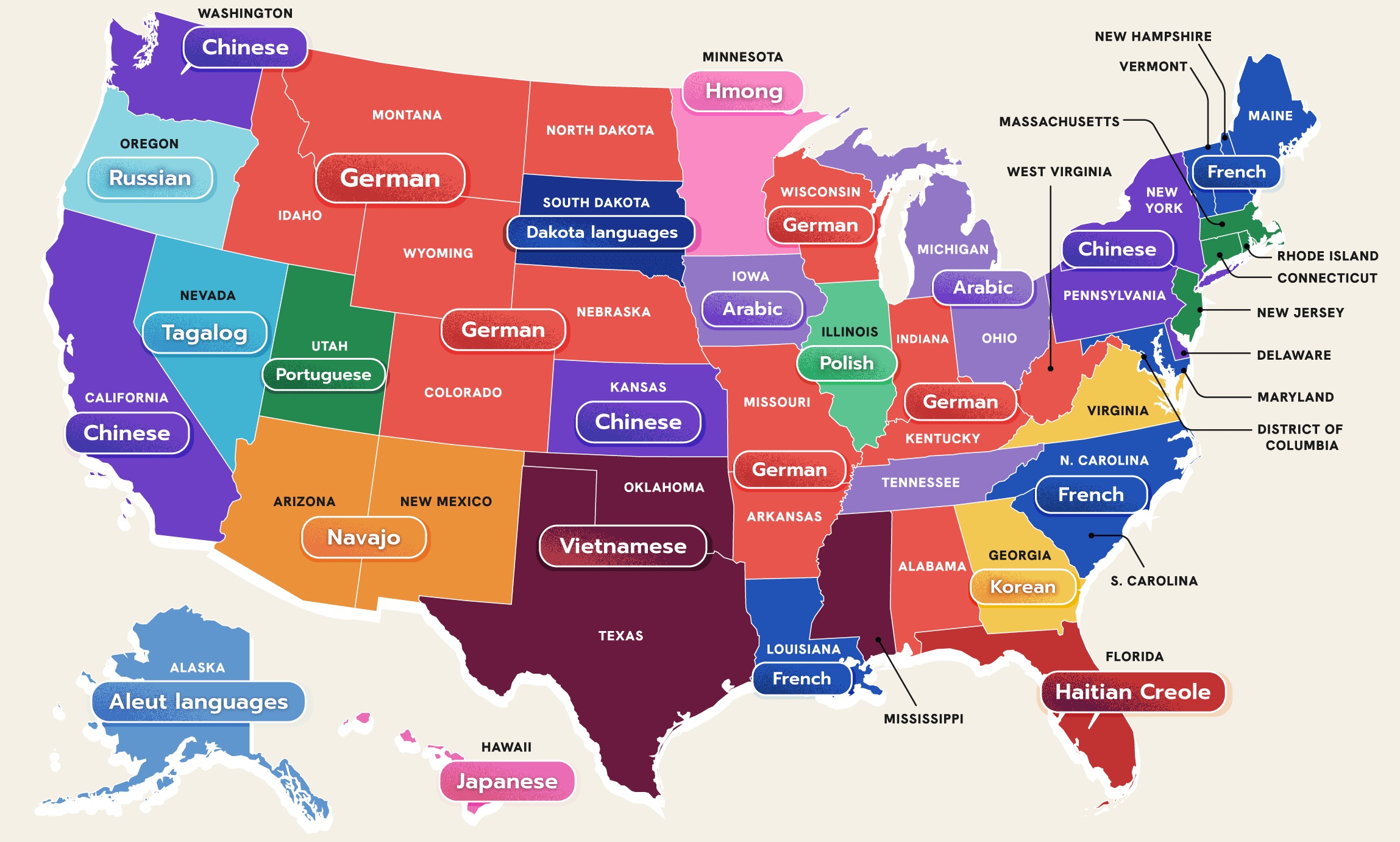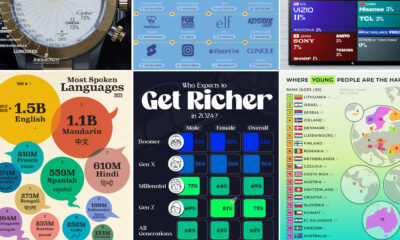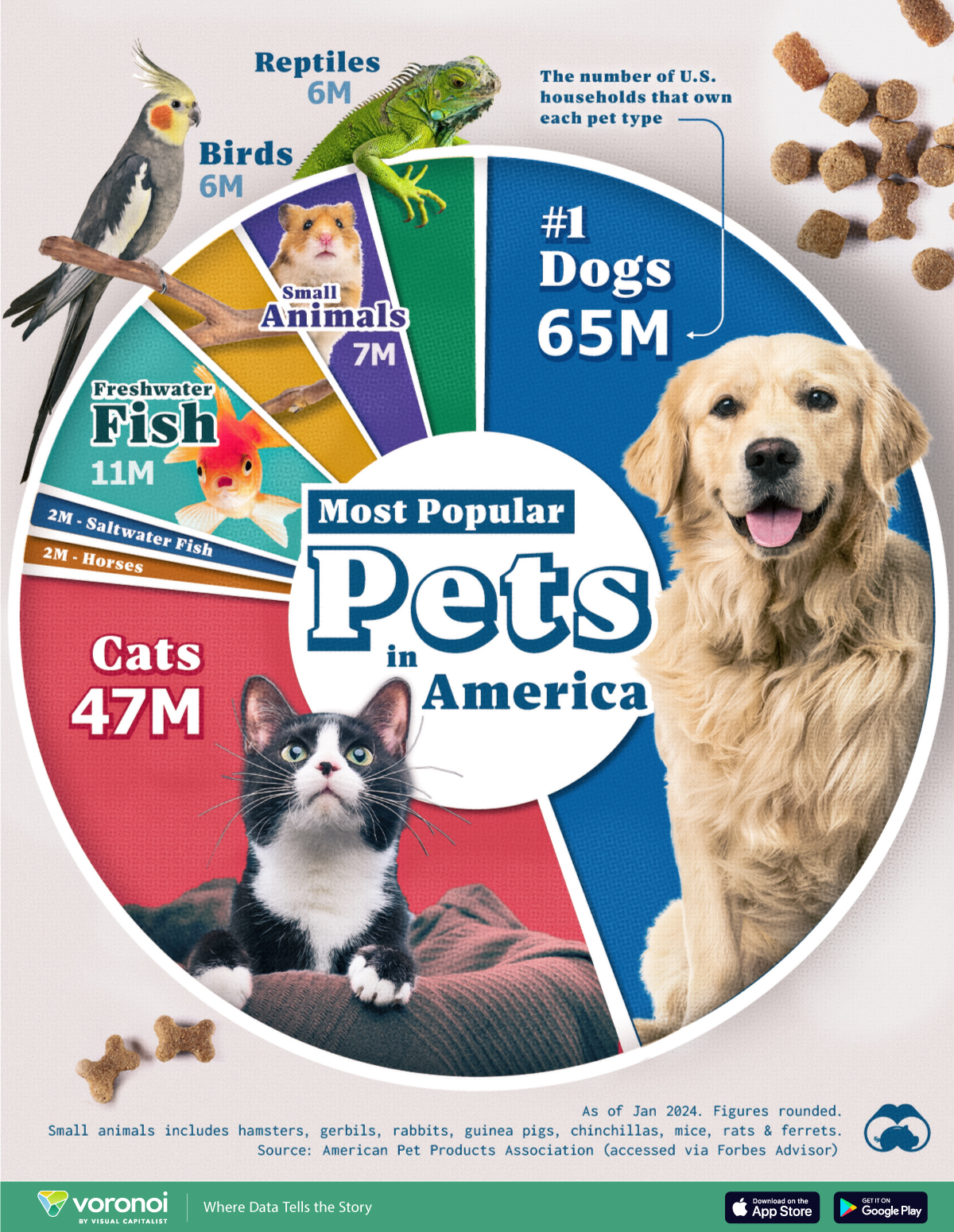Misc
The Most Spoken Language in Every U.S. State (Besides English and Spanish)
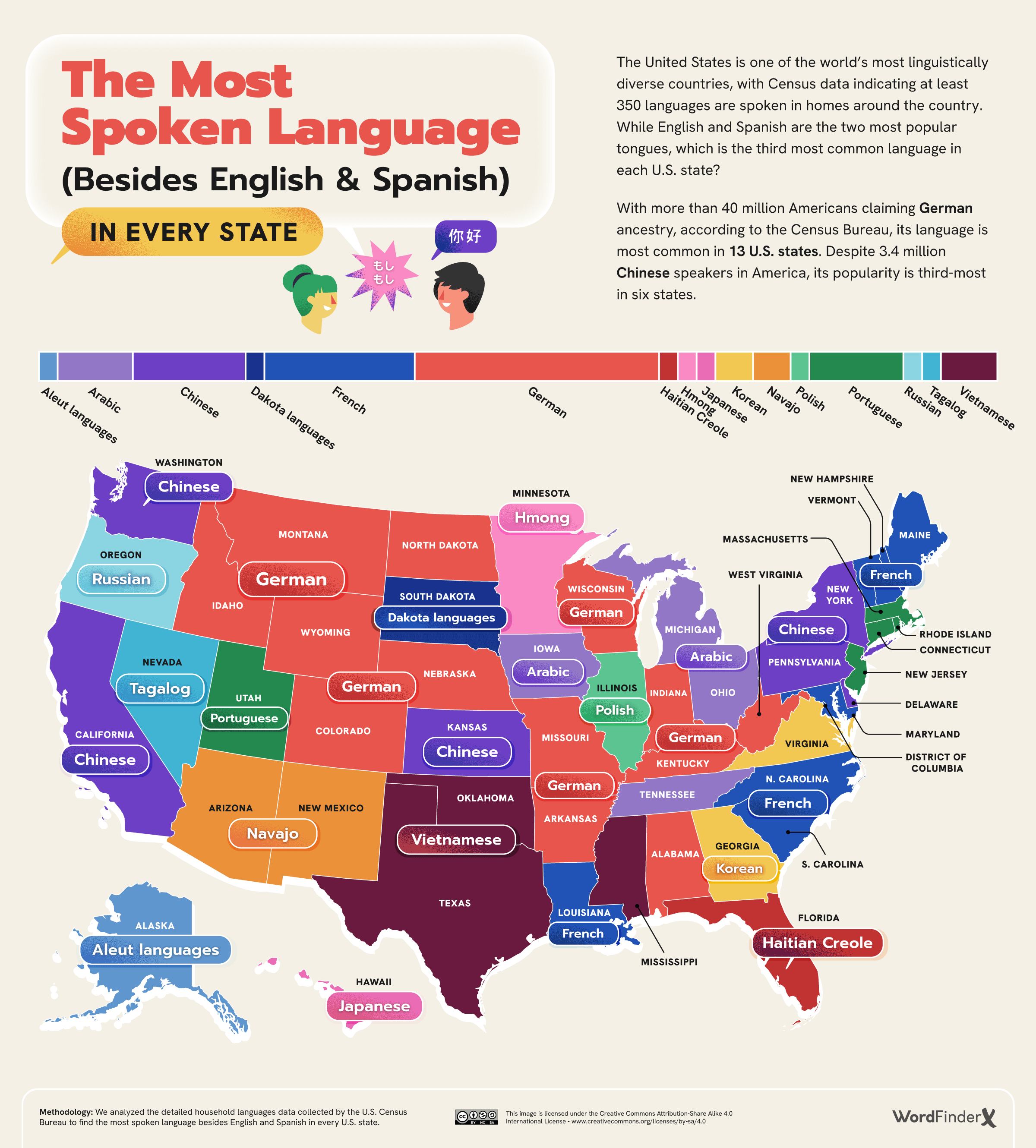
The Most Spoken Language in Every U.S. State (Besides English and Spanish)
While 78% of Americans speak only English at home, between 350 and 430 languages can be found in the United States.
Spanish is the second most common language, spoken in 62% of non-English-speaking households.
In this graphic, WordFinderX used Census data to uncover the most spoken languages (aside from English and Spanish) in American neighborhoods.
German is the Most Spoken Language in 13 States
During the mid-18th century, German immigrants played a significant role in early American society. They constituted one-third of the population of American colonies, ranking second in numbers only to the English.
As a consequence, German now stands as the third most prevalent language in 13 states, with over 40 million Americans claiming German ancestry.
| State | Most Spoken Language (Besides English and Spanish) |
|---|---|
| Alaska | Aleut languages |
| Alabama | German |
| Arkansas | German |
| Arizona | Navajo |
| California | Chinese |
| Colorado | German |
| Connecticut | Portuguese |
| District of Columbia | French |
| Delaware | Chinese |
| Florida | Haitian Creole |
| Georgia | Korean |
| Hawaii | Japanese |
| Iowa | Arabic |
| Idaho | German |
| Illinois | Polish |
| Indiana | German |
| Kansas | Chinese |
| Kentucky | German |
| Louisiana | French |
| Massachusetts | Portuguese |
| Maryland | French |
| Maine | French |
| Michigan | Arabic |
| Minnesota | Hmong |
| Missouri | German |
| Mississippi | Vietnamese |
| Montana | German |
| North Carolina | French |
| North Dakota | German |
| Nebraska | German |
| New Hampshire | French |
| New Jersey | Portuguese |
| New Mexico | Navajo |
| Nevada | Tagalog |
| New York | Chinese |
| Ohio | Arabic |
| Oklahoma | Vietnamese |
| Oregon | Russian |
| Pennsylvania | Chinese |
| Rhode Island | Portuguese |
| South Carolina | French |
| South Dakota | Dakota languages |
| Tennessee | Arabic |
| Texas | Vietnamese |
| Utah | Portuguese |
| Virginia | Korean |
| Vermont | French |
| Washington | Chinese |
| Wisconsin | German |
| West Virginia | German |
| Wyoming | German |
From military aid to ideological support, France played a pivotal role in the success of the American Revolution. More than two centuries later, approximately 9.4 million people in the U.S. claim French or French-Canadian ancestry.
In the Midwest, French stands as the most spoken language (following English and Spanish) in four major cities.
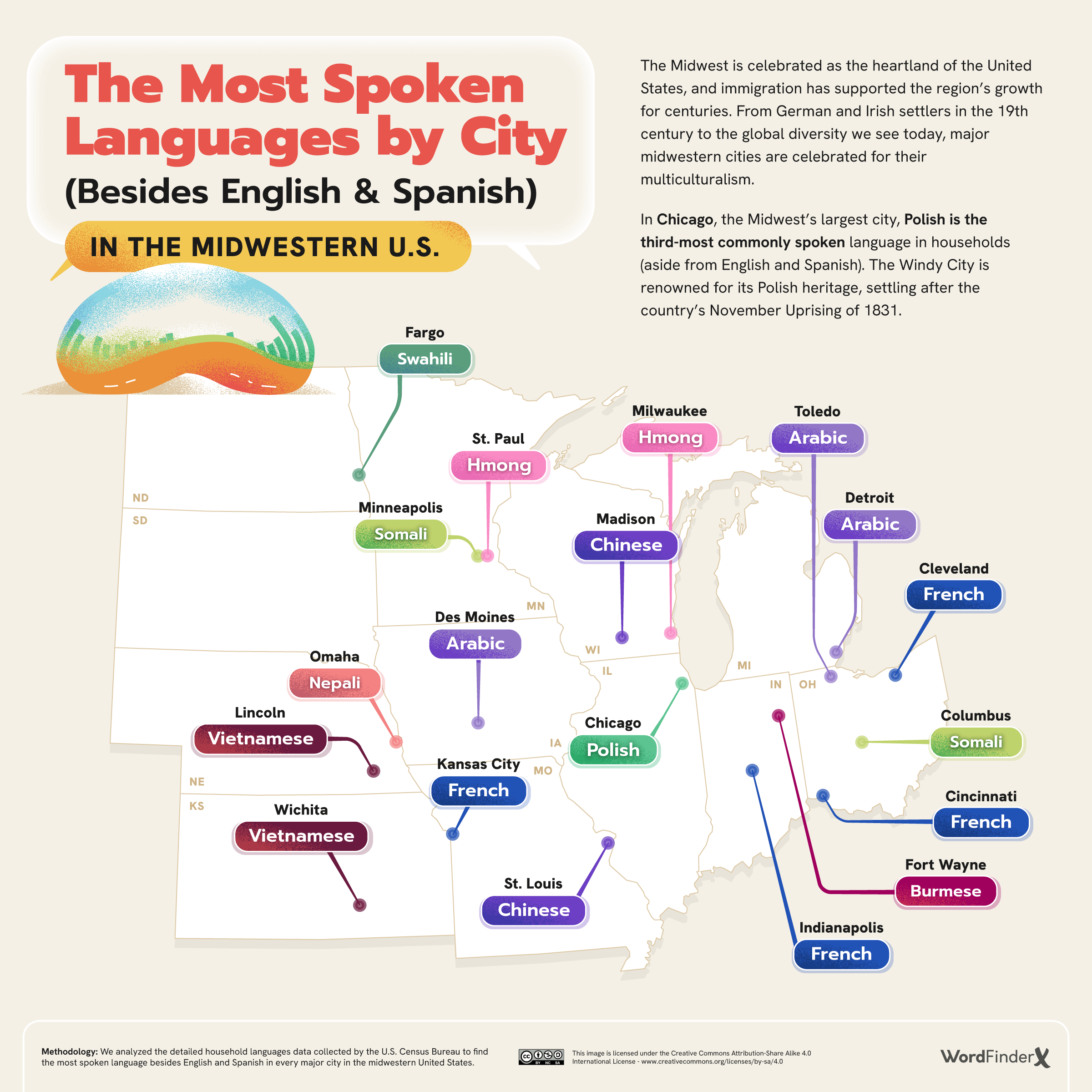
In the Midwest’s largest city, Chicago, Polish is the third-most common spoken language.
Asian Languages in the American West
The American West is home to 45% of all U.S. Asians, making Asian languages the most spoken in many cities, following English and Spanish.
Tagalog is the most spoken language in nine cities, ranging from Anchorage, Alaska, where half of the local Asian community is Filipino, to Las Vegas, Nevada, home to one of the largest Filipino-American communities in the country.
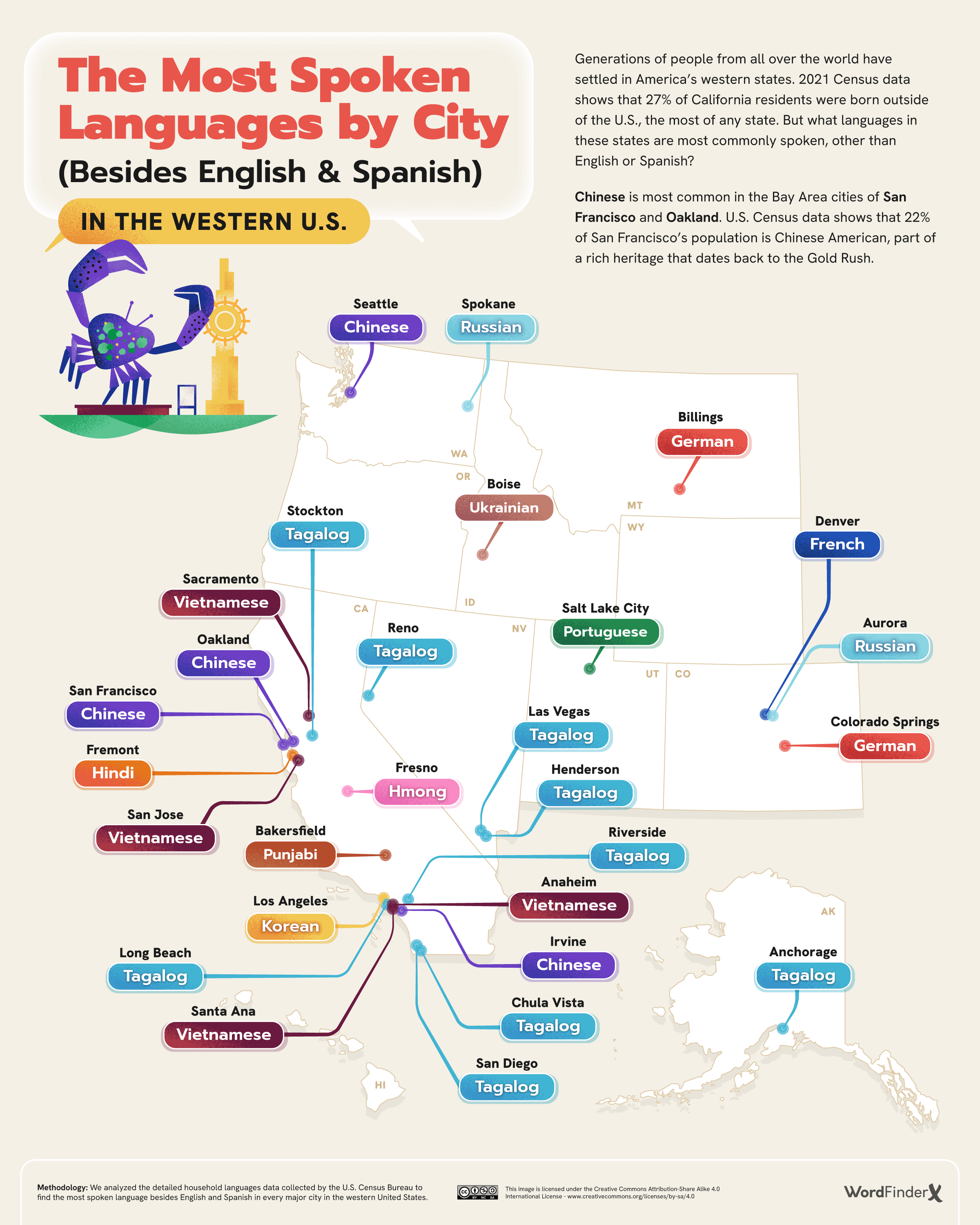
Chinese dominates in California and Washington, while Japanese ranks as the third most common language in Hawaii.
The Most Spoken Languages in New York
In the late 1800s, people worldwide chose to emigrate to the United States, leaving their homes due to crop failure, land and job shortages, rising taxes, and famine. Many also saw the U.S. as a land of economic opportunity.
More than 70% of all immigrants entered through New York City, which came to be known as the “Golden Door.”
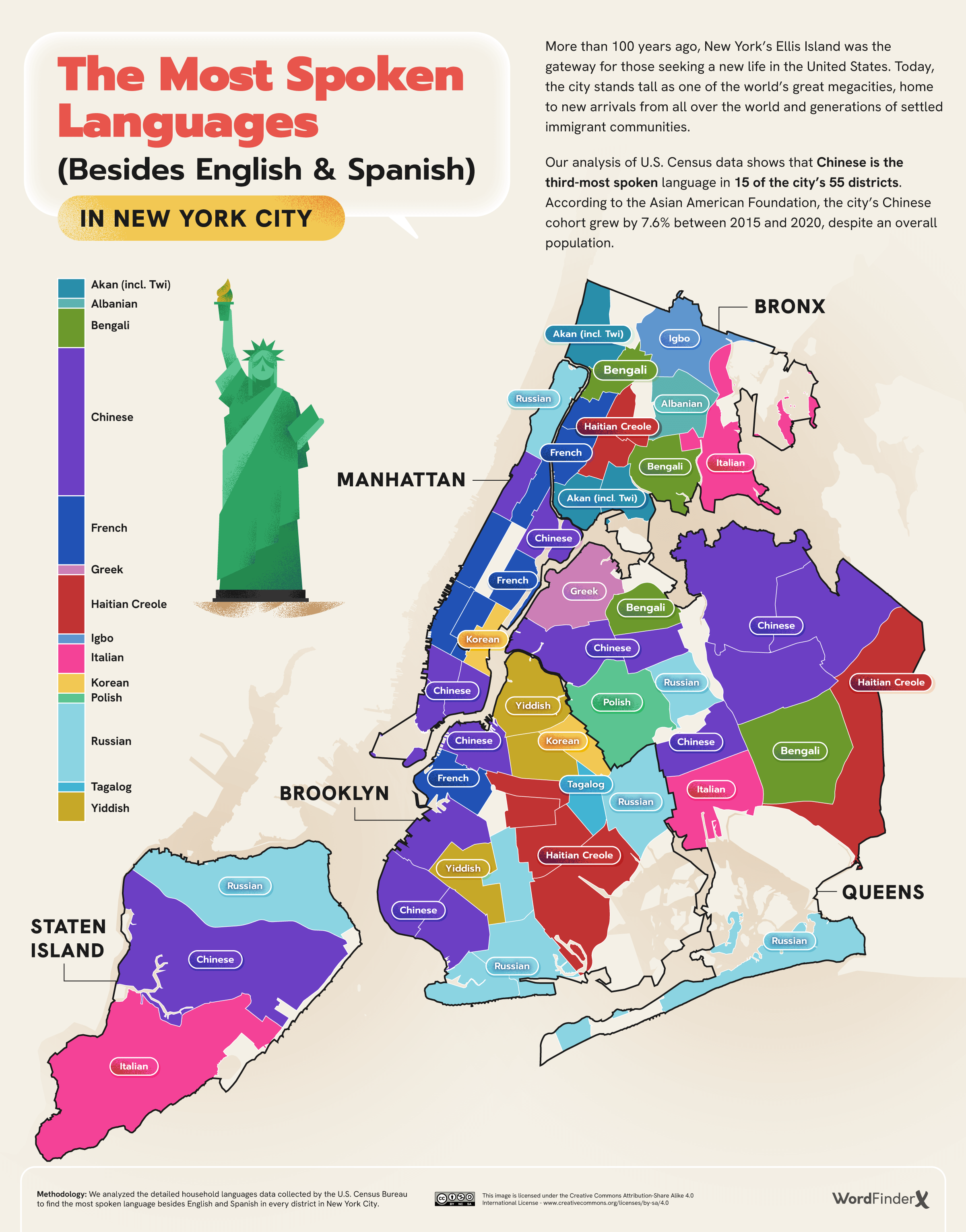
As a result, the city today has an eclectic mix of languages.
While numerous languages across America thrive, some face imminent extinction. These include rare regional dialects, like the Pawpaw French in Minnesota, and indigenous languages.
According to the National Congress of American Indians, all surviving Native American languages are severely endangered, with over 90% of them at risk of extinction by 2050.
Various initiatives, including leveraging technology, have been proposed to ensure the preservation of the diverse cultures and languages in the U.S.

This article was published as a part of Visual Capitalist's Creator Program, which features data-driven visuals from some of our favorite Creators around the world.
United States
Visualizing the Most Common Pets in the U.S.
Lions, tigers, and bears, oh my!—these animals do not feature on this list of popular American household pets.

Visualizing The Most Common Pets in the U.S.
This was originally posted on our Voronoi app. Download the app for free on iOS or Android and discover incredible data-driven charts from a variety of trusted sources.
In this graphic, we visualized the most common American household pets, based on 2023-2024 data from the American Pet Products Association (accessed via Forbes Advisor).
Figures represent the number of households that own each pet type, rather than the actual number of each animal. The “small animal” category includes hamsters, gerbils, rabbits, guinea pigs, chinchillas, mice, rats, and ferrets.
What is the Most Popular American Household Pet?
Based on this data, dogs—one of the first domesticated animals—are the most common pets in the United States. In fact, around 65 million households own a dog, and spend an average of $900 a year on their care.
| Rank | Species | Households |
|---|---|---|
| 1 | 🐶 Dog | 65M |
| 2 | 🐱 Cat | 47M |
| 3 | 🐟 Freshwater Fish | 11M |
| 4 | 🐰 Small Animals | 7M |
| 5 | 🐦 Bird | 6M |
| 6 | 🦎 Reptile | 6M |
| 7 | 🐴 Horse | 2M |
| 8 | 🐠 Saltwater Fish | 2M |
Note: Households can own multiple pets, and are counted for all relevant categories.
Cats rank second, at 47 million households, and these smaller felines are a little less expensive to own at $700/year according to Forbes estimates.
But aside from these two juggernauts, there are plenty of other common pet types found in households across the country.
Freshwater fish can be found in 11 million households, along with small animals—rabbits, hamsters, guinea pigs—in 7 million. Meanwhile, nearly 6 million homes have birds or reptiles.
Pet Ownership is on the Rise in America
Forbes found that 66% of all American households (numbering 87 million) own at least one pet, up from 56% in 1988. One third of these (29 million) own multiple pets.
A combination of factors is driving this increase: rising incomes, delayed childbirth, and of course the impact of the pandemic which nearly cleared out animal shelters across the globe.
America’s loneliness epidemic may also be a factor. Fledgling research has shown that single-individual households with pets recorded lower rates of loneliness during the pandemic than those without a pet.
-

 Culture1 week ago
Culture1 week agoThe Highest Earning Athletes in Seven Professional Sports
-

 Demographics2 weeks ago
Demographics2 weeks agoPopulation Projections: The World’s 6 Largest Countries in 2075
-

 Markets2 weeks ago
Markets2 weeks agoThe Top 10 States by Real GDP Growth in 2023
-

 Demographics2 weeks ago
Demographics2 weeks agoThe Smallest Gender Wage Gaps in OECD Countries
-

 United States2 weeks ago
United States2 weeks agoWhere U.S. Inflation Hit the Hardest in March 2024
-

 Green2 weeks ago
Green2 weeks agoTop Countries By Forest Growth Since 2001
-

 United States2 weeks ago
United States2 weeks agoRanked: The Largest U.S. Corporations by Number of Employees
-

 Maps2 weeks ago
Maps2 weeks agoThe Largest Earthquakes in the New York Area (1970-2024)

